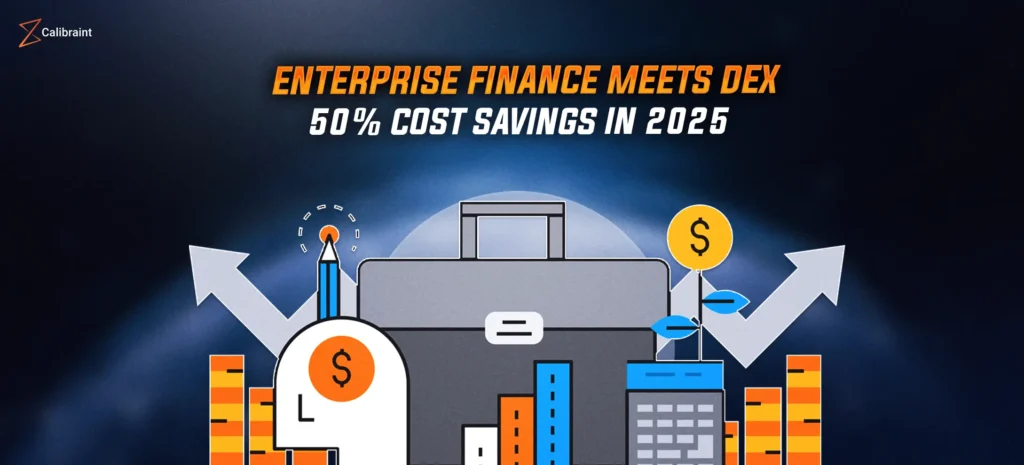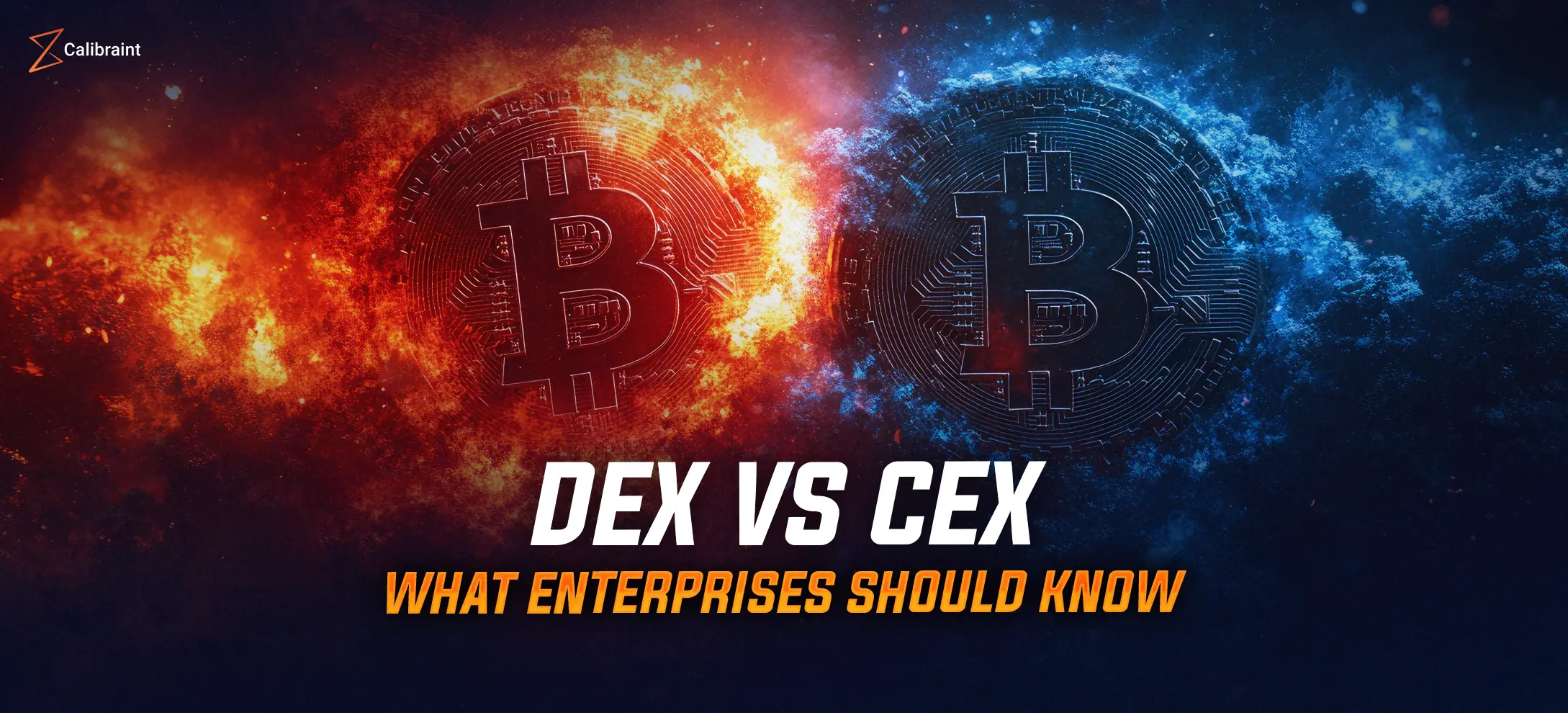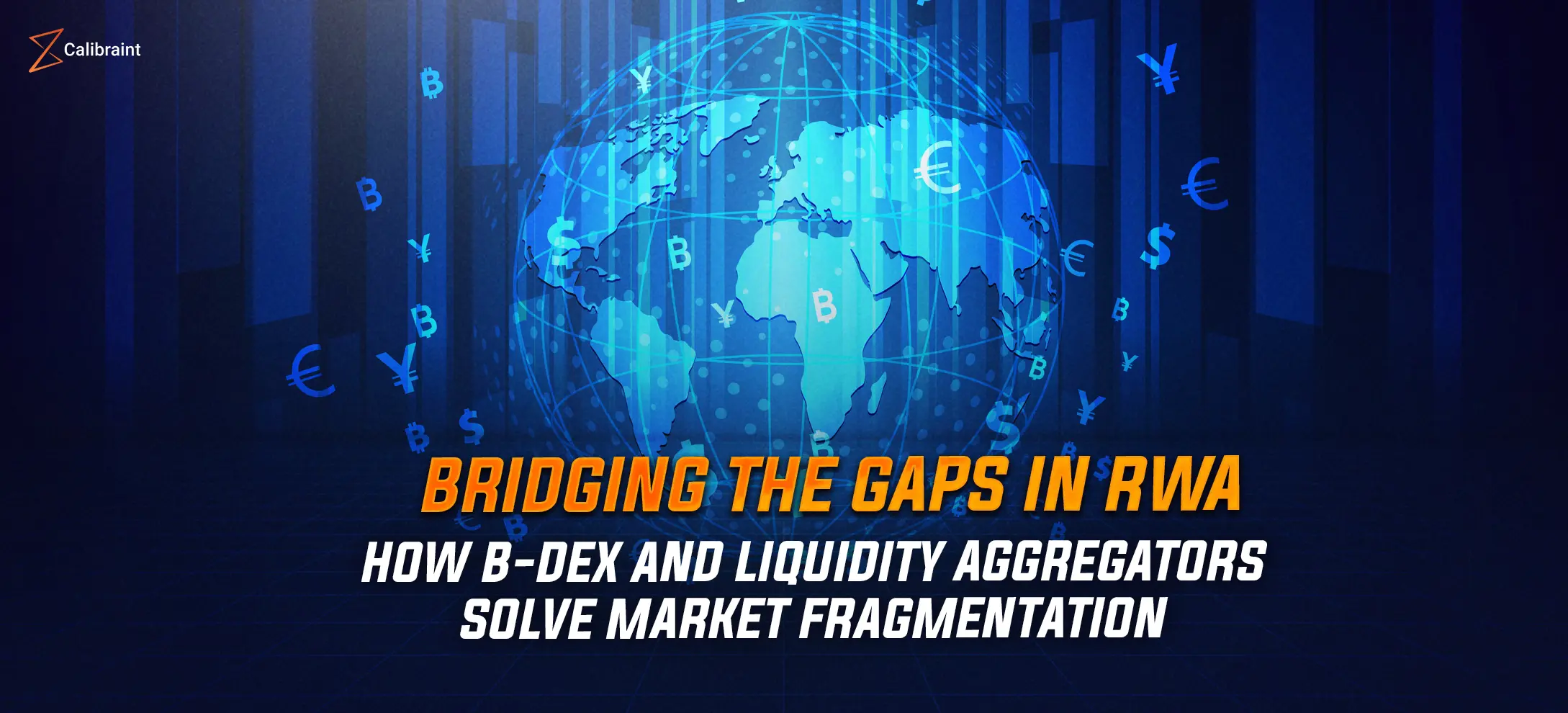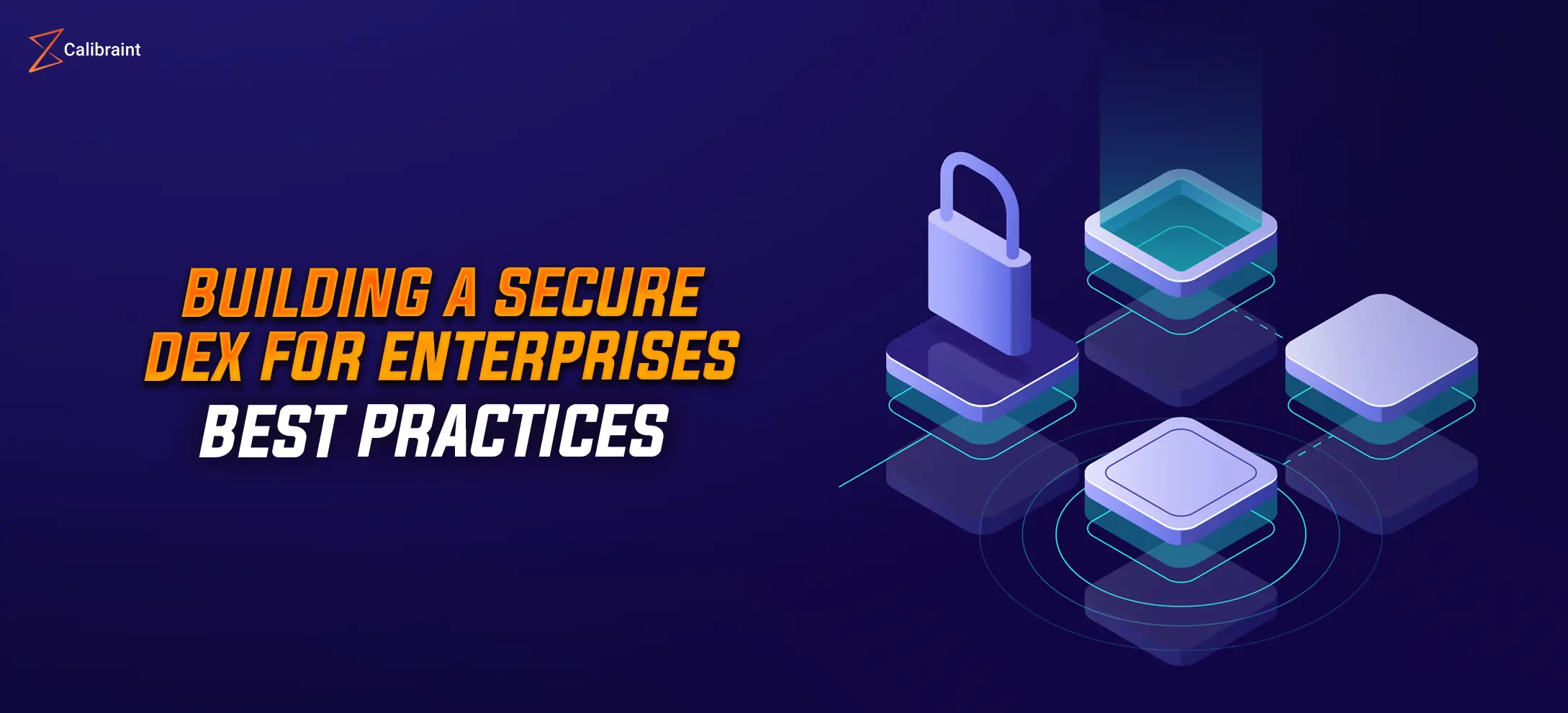Decentralized Exchange for Enterprise Finance: Unlocking 50% Cost Savings and Liquidity in 2025
Calibraint
Author
September 29, 2025
Last updated: November 14, 2025

Transforming Enterprise Finance Through Decentralized Exchanges
Enterprises today face mounting pressure to optimize financial operations while managing growing cross-border transactions, liquidity bottlenecks, and rising operational costs. Traditional banking intermediaries, slow settlements, and high transaction fees remain persistent challenges for finance and treasury teams. The question facing organizations managing global operations is clear: How can businesses reduce costs, accelerate settlements, and gain full visibility into liquidity across multiple jurisdictions?
The answer increasingly lies in the adoption of Decentralized Exchange for Enterprise Finance, a transformative approach that unlocks operational efficiency, transparency, and measurable ROI. By leveraging blockchain-enabled DEX platforms, enterprises can access on-demand liquidity, optimize treasury management, and achieve cost savings of up to 50% by 2025.
As businesses compete in a landscape where financial agility and capital efficiency determine competitive advantage, decentralized exchanges are emerging as a strategic tool rather than a niche innovation. They offer a way to reimagine finance workflows, reduce reliance on intermediaries, and create a more resilient treasury infrastructure.
The Current Enterprise Finance Challenge
Despite decades of technological innovation, enterprise finance continues to rely heavily on centralized intermediaries. Cross-border payments frequently involve multiple banks, clearinghouses, and SWIFT networks, creating a cascade of inefficiencies.
High transaction costs remain a primary concern. Currency conversion spreads, intermediary fees, and settlement charges accumulate rapidly, often eroding corporate margins. For multinational organizations handling numerous transactions each month, these costs are significant.
Liquidity constraints further exacerbate the problem. Many enterprises struggle to access global liquidity pools instantly, forcing them to maintain large pre-funded accounts or accept delays in critical payments. Idle cash in multiple jurisdictions represents lost opportunity costs that could otherwise be deployed for strategic initiatives.
Slow settlement cycles also challenge enterprise finance. Traditional workflows can take two to three days, delaying working capital deployment and complicating cash flow planning. The result is a treasury function that is reactive rather than strategic.
Opacity and compliance complexity further hinder operational efficiency. Multiple touchpoints across banks and intermediaries reduce transparency, increase reconciliation overhead, and heighten regulatory risk. Finance teams often spend significant time verifying transactions instead of focusing on forward-looking financial planning.
In 2025, enterprises seeking to maintain competitiveness require Enterprise DEX Liquidity Solutions that streamline transactions, enhance cash flow, and provide real-time transparency. Decentralized exchanges replace intermediaries with blockchain-based peer-to-peer networks that are secure, auditable, and globally accessible, offering a compelling alternative to legacy finance workflows.
Understanding Decentralized Exchange for Enterprise Finance
At its core, a Decentralized Exchange for Enterprise Finance is a blockchain-enabled platform that allows enterprises to trade digital assets, currencies, or tokenized cash equivalents directly, bypassing traditional intermediaries. Unlike conventional finance networks, DEX platforms operate through smart contracts that automate transactions, ensuring trust, security, and efficiency without manual intervention.
The strategic advantage of a DEX is multi-fold. Enterprises gain faster settlements, reduced transaction costs, and direct access to global liquidity pools. These benefits directly enhance treasury performance, improve financial reporting, and enable decision-makers to focus on strategic priorities rather than routine processing.
Unlike traditional finance systems, where settlement delays and opaque processes are the norm, DEX platforms provide near-instant execution. This speed, combined with minimal transaction fees, allows enterprises to redirect capital that would otherwise sit idle and optimize cash flow for operational or investment purposes.
For organizations exploring advanced treasury strategies, hybrid solutions combining DEX platforms with algorithmic trading capabilities can further enhance efficiency. Learn more about these innovations in DEX and trading bot hybrid solutions.
Key Benefits for Enterprises
Cost Efficiency: Up to 50% Savings
One of the most compelling benefits of adopting a Decentralized Exchange for Enterprise Finance is significant cost reduction. Traditional finance intermediaries charge substantial fees for cross-border transactions, foreign exchange conversions, and clearing services. By leveraging DEX platforms, enterprises can eliminate intermediaries, streamline settlements, and reduce transactional overhead.
The result is a measurable impact on operating margins. Enterprises adopting DEX platforms can achieve cost reductions of up to 50% in optimized scenarios. Beyond direct savings, reduced dependency on intermediaries allows treasury teams to negotiate better terms with service providers and repurpose capital toward strategic growth initiatives.
Liquidity Access
Liquidity is the lifeblood of enterprise finance, and DEX platforms revolutionize access to it. By providing on-demand, global liquidity pools, these platforms allow enterprises to transact without pre-funding accounts in multiple regions.
Enterprise DEX Liquidity Solutions empower treasury teams to deploy cash dynamically, respond swiftly to market fluctuations, and optimize short-term investments. Organizations gain enhanced operational agility, stronger control over working capital, and greater ability to capitalize on financial opportunities in real-time. By implementing enterprise DEX liquidity strategies across multiple jurisdictions, companies can achieve better utilization of capital while reducing dependency on legacy banking structures.
Treasury Optimization
Integration of DEX platforms with corporate treasury systems introduces new levels of operational efficiency. DEX for Corporate Treasury Management enables pre-approved settlement flows through smart contracts, instant cross-border transfers, and real-time monitoring of liquidity positions.
This level of integration transforms treasury operations from reactive to proactive. Teams gain a holistic view of global liquidity positions, automate routine processes, and focus on forward-looking financial planning. Automation reduces errors, speeds reconciliation, and frees resources to focus on strategic financial initiatives. Furthermore, combining DEX for Corporate Treasury Management with liquidity solutions ensures maximum ROI and improved operational control.
Transparency and Security
Blockchain-based DEX platforms provide immutable audit trails, end-to-end visibility, and cryptographically secure transactions. For enterprises, this translates into enhanced compliance reporting, lower fraud risk, and simplified internal audits. Transparency ceases to be a regulatory burden and becomes a strategic differentiator, allowing decision-makers to demonstrate robust governance and risk management. By leveraging Enterprise DEX Liquidity Solutions, organizations can also integrate robust reporting and analytics, improving both operational transparency and financial insight.
Key Applications and Considerations
Overcoming DEX Integration Challenges Enterprise
While the advantages are clear, successful DEX adoption requires careful consideration of integration challenges. Enterprises must address:
- Regulatory compliance: Aligning DEX transactions with local and global financial regulations to maintain adherence without disrupting operations.
- System interoperability: Ensuring seamless integration with ERP, treasury management systems, and legacy finance platforms to maintain consistent workflows.
- User experience: Providing intuitive dashboards and reporting tools that teams can use to monitor, analyze, and act on liquidity and settlement data.
By proactively addressing these considerations, enterprises can accelerate adoption and fully realize the advantages of a Decentralized Exchange for Enterprise Finance. Successfully overcoming DEX integration challenges enterprise-wide ensures smoother workflows, reduces risk, and improves ROI metrics across treasury operations.
Measuring Success: DEX ROI Metrics for Enterprises
Organizations evaluating DEX adoption require clear, actionable metrics to justify strategic investment. Key DEX ROI Metrics for Enterprises include:
- Reduction in transaction and intermediary costs
- Improvement in liquidity utilization and cash deployment
- Faster settlement cycles impacting working capital efficiency
- Yield optimization on idle funds through corporate DeFi strategies
By quantifying these metrics, finance leaders can demonstrate measurable value to boards and stakeholders. Consistently tracking DEX ROI Metrics for Enterprises allows organizations to refine liquidity strategies, optimize treasury operations, and maximize efficiency from adoption.
Enterprise Use Cases
- Multinational organizations managing cross-border treasury flows: DEX platforms enable instantaneous global settlements, significantly reducing FX costs and operational delays while integrating with existing DEX for Corporate Treasury Management workflows.
- High-frequency B2B settlements: Enterprises executing hundreds of daily transactions can streamline operations, optimize cash flow, and minimize reconciliation overhead using Enterprise DEX Liquidity Solutions.
- Optimizing idle capital: Corporates can deploy excess cash into scalable, interest-bearing DEX pools, leveraging Scalable DEX Platforms for Corporate Finance while tracking DEX ROI Metrics for Enterprises to earn incremental returns without sacrificing liquidity.
Real-World Scenario: DEX in Action
Consider an enterprise with a treasury desk managing USD, EUR, and JPY flows. Under traditional systems, cross-border settlements take 2–3 days, with banks charging 2–3% in FX and transfer fees. Idle funds in each jurisdiction result in lost opportunity costs.
Before DEX adoption:
- Settlements took three days or more
- $1.2M annual intermediary fees
- Fragmented liquidity and inefficient capital deployment
After implementing DEX for Enterprise Payment Optimization 2025:
- Instant settlements across currencies
- $600K annual cost savings, representing a 50% reduction
- Real-time liquidity monitoring and automated treasury flows
- Enhanced auditability and regulatory compliance
By leveraging enterprise-focused liquidity pools modeled after Uniswap and lending protocols adapted from Aave/Compound, the treasury team transformed operational efficiency, reduced costs, and significantly enhanced overall financial performance. Overcoming DEX integration challenges enterprise-wide was key to achieving these outcomes.
The Future of Enterprise Finance with DEX
The adoption of Decentralized Exchange for Enterprise Finance is poised to accelerate in 2025. Enterprises will increasingly embrace hybrid models that combine DeFi innovations with traditional finance infrastructure. Regulatory clarity, improved interoperability standards, and institutional-grade platforms will drive broader adoption across industries.
For organizations, early adoption provides not only cost savings but strategic advantages. Businesses gain greater control over liquidity, faster decision-making capabilities, improved risk management, and measurable ROI on treasury operations. By leveraging DEX for Corporate Treasury Management and Enterprise DEX Liquidity Solutions, companies can future-proof treasury operations while ensuring consistent DEX ROI Metrics for Enterprises.
To unlock these benefits and explore how a Decentralized Exchange for Enterprise Finance can transform your enterprise operations, connect with Calibraint’s DEX development services today. Leverage expert guidance, scalable platforms, and enterprise-grade liquidity solutions to achieve operational efficiency and strategic growth in 2025 and beyond.
Calibraint
Author
September 29, 2025
Last updated: November 14, 2025



























